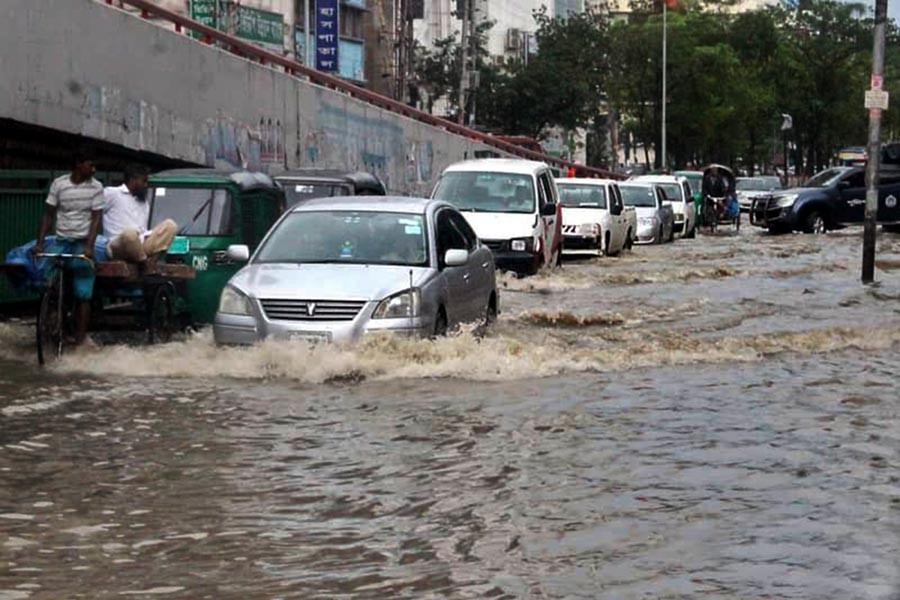
Published :
Updated :

In July of last year, State Minister for Rural Development and Co-operatives Mashiur Rahman Ranga said at the parliament, "Work is underway to resolve the city's (Dhaka) waterlogging problem. So, there will be no knee-deep water in Dhaka from the next year."
But citizens of Dhaka are still facing waterlogging and various other issues, this year. These can be attributed to the lack of focus from authorities like Dhaka Water Supply and Sewerage Authority (DWASA) and Dhaka North and South City Corporations.
Given the number of decades that these problems have persisted in the city, there is little hope that there will be any significant improvements in the short run.
And this is not helping as Dhaka is the nucleus of country's administrative, industrial, commercial, educational and political activities. The capital is plagued with dense population, narrow roads, depleting number of wetlands, a lack of open spaces and parks, traffic congestion, poor access to transportation facilities, increasing environmental degradation, weak governance and coordination among duty bearers, violation of building code and lack of hazard specific preparedness. All these problems are increasing the susceptibility of the city to disasters like floods, waterlogging, fire, building collapse due to earthquake, disease epidemics and various forms of pollution.
The consequences of such disasters were felt in the past severely.
After the flood of 1988, the western part of Dhaka City was being protected by embankments and raised roads. In spite of protective measures for Dhaka West, floods in 1998 and 2004 affected both the protected western part and the unprotected eastern part of the city. Over 50 per cent of the city's population, majority of them living in slums, was badly affected.
In 2007, around 90,000 citizens suffered a diarrhea epidemic, caused from and spread through a week-long flood.
Flood and waterlogging risk management in the capital requires human sensitivity and intervention. These require extraordinary decisions and actions.
The interventions can vary depending on the intensity of the disaster, the capacity of the public authority and the circumstances being faced by the community. Political considerations on the part of policymakers also play a significant factor in the preparation for, response to, recovery from, mitigation of and prevention from disasters.
REDUCTION OF RISKS AND SUFFERINGS: The various government departments are expected to work towards solving the city's problems and mitigate disasters in line with the Disaster Management Vision and the different ministries.
The government's Disaster Management Vision is aimed at reducing the risk of people, especially the poor and the disadvantaged, from the effects of natural, environmental and human induced hazards, to a manageable and acceptable humanitarian level, and to have in place an efficient emergency response system capable of handling large scale disasters.
To decrease the vulnerability of the city to different disasters, the government can integrate disaster risk reduction in ongoing development works and future initiatives by different government ministries/departments and Non-Governmental organisations (NGOs). Concerned authorities can develop a hazard database which can be used to carry out detailed study and planning.
Some measures can be taken to reclaim wetlands, flood flow zones, rainstorm water preservation ponds and waterways from illegal occupation.
The government authorities and NGOs can also redesign development programmes with active participation of the most affected city-dwellers to ensure that they maximise the potential of disaster mitigation and incorporate traditional community coping practices which are technically, politically, environmentally and economically fit.
Some targeted but tested risk reduction activities, both structural (waterways protection, infrastructure) and non-structural, can be undertaken in consultation with communities at risk and relevant experts/organisations.
Appropriate feasibility and cost benefit analyses by independent authorities are very necessary before taking any structural initiatives. A public hearing and consultation is important in this regard.
Proper steps along with political determination, administrative diligence, appropriate resources, and accurate planning, monitoring and community-feedback mechanism are urgently required to fix the problems the city-dwellers face.
Farid Hasan Ahmed is a development lawyer.
farid.hasan2008@gmail.com


 For all latest news, follow The Financial Express Google News channel.
For all latest news, follow The Financial Express Google News channel.